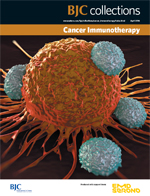Collection on Cancer Immunotherapy

Editorial
By Professor Adrian L Harris
Editor-in-Chief
In the last five years, cancer therapy has been revolutionised by the effective introduction of immunotherapies.
In particular, antibodies that block cytotoxic T-lymphocyte-associated protein 4 [CTLA-4] or Programmed death-ligand 1 [PDL1 ] and so reduce signals that inhibit T cell function, have proved efficacious in producing complete regressions that are maintained for years, in melanoma and other tumours, for example bladder cancer and non-small cell lung cancer.
Additionally, the emerging success, in end-stage patients, of chimeric antigen receptor T cells has produced remarkable responses even in patients with end-stage disease, who have failed multiple other therapies.
These two important ways of harnessing immunotherapy have led to it being called the 'fifth pillar' of cancer treatment. There remain many other mechanisms and pathways to be considered in optimising these treatments, selecting patients for therapy, predicting response and so improving the current results.
This collection of papers covers these areas, including reviews of the pathways of immune modulation for cancer therapy, detection of tumour antigens by mRNA analysis in blood, directions of immunotherapy with selective targeting agents such as HER2, the role of inflammatory micro environment, generation of suitable tumour infiltrating lymphocytes, predictive and prognostic biomarkers for response, and improvement of vaccination approaches.
Further investigation in parallel with therapeutic trials will be needed to optimise the outcomes, to use agents selectively and to understand resistance mechanisms.
The recent exciting results with antibodies against signalling molecules that suppress T cell responses, show improved survival and responses in tumour types not consider to be targets for immunotherapy previously. Immunotherapy has become rapidly established as a mainline therapy and this collection of articles combines basic, translational, clinical and review papers that provide a current analysis and background to the field.
Collection
Top of pageA distinct pre-existing inflammatory tumour microenvironment is associated with chemotherapy resistance in high-grade serous epithelial ovarian cancer Open
M Koti, A Siu, I Clément, M Bidarimath, G Turashvili, A Edwards, K Rahimi, A-M M Masson and J A Squire
Br J Cancer 112: 1215-1222; advance online publication, March 12, 2015; doi:10.1038/bjc.2015.81
 Abstract | Full Text | PDF |
Supplementary information
Abstract | Full Text | PDF |
Supplementary information
Efficient and reproducible generation of tumour-infiltrating lymphocytes for renal cell carcinoma FREE
V Baldan, R Griffiths, R E Hawkins and D E Gilham
Br J Cancer 112: 1510-1518; advance online publication, March 17, 2015; doi:10.1038/bjc.2015.96
Abstract | Full Text | PDF | Supplementary information
Epithelial-to-mesenchymal transition (EMT) induced by inflammatory priming elicits mesenchymal stromal cell-like immune-modulatory properties in cancer cells Open
M Ricciardi, M Zanotto, G Malpeli, G Bassi, O Perbellini, M Chilosi, F Bifari and M Krampera
Br J Cancer 112: 1067-1075; advance online publication, February 10, 2015; doi:10.1038/bjc.2015.29
 Abstract | Full Text | PDF |
Supplementary information
Abstract | Full Text | PDF |
Supplementary information
Prognostic and predictive value of immunological parameters for chemoradioimmunotherapy in patients with pancreatic adenocarcinoma Open
S Karakhanova, E Ryschich, B Mosl, S Harig, D Jäger, J Schmidt, W Hartwig, J Werner and A V Bazhin
Br J Cancer 112: 1027-1036; advance online publication, March 5, 2015; doi:10.1038/bjc.2015.72
 Abstract | Full Text | PDF |
Supplementary information
Abstract | Full Text | PDF |
Supplementary information
Immune modulation for cancer therapy Open
J Naidoo, D B Page and J D Wolchok
Br J Cancer 111: 2214-2219; advance online publication, September 11, 2014; doi:10.1038/bjc.2014.348
HER2-positive advanced breast cancer: optimizing patient outcomes and opportunities for drug development Open
J C Singh, K Jhaveri and F J Esteva
Br J Cancer 111: 1888-1898; advance online publication, July 15, 2014; doi:10.1038/bjc.2014.388
Circulating cell-free cancer-testis MAGE-A RNA, BORIS RNA, let-7b and miR-202 in the blood of patients with breast cancer and benign breast diseases Open
S A Joosse, V Müller, B Steinbach, K Pantel and H Schwarzenbach
Br J Cancer 111: 909-917; advance online publication, July 1, 2014; doi:10.1038/bjc.2014.360
 Abstract | Full Text | PDF |
Supplementary information
Abstract | Full Text | PDF |
Supplementary information
Translation of genomics-guided RNA-based personalised cancer vaccines: towards the bedside Open
V Boisguérin, J C Castle, M Loewer, J Diekmann, F Mueller, C M Britten, S Kreiter, Ö Türeci and U Sahin
Br J Cancer 111: 1469-1475; doi:10.1038/bjc.2013.820
Tumour microenvironment of both early- and late-stage colorectal cancer is equally immunosuppressive Open
A O'Toole, A J Michielsen, B Nolan, M Tosetto, K Sheahan, H E Mulcahy, D C Winter, J M Hyland, P R O'Connell, D Fennelly, D O'Donoghue, J O'Sullivan, G A Doherty and E J Ryan
Br J Cancer 111: 927-932; advance online publication, July 24, 2014; doi:10.1038/bjc.2014.367
Direct incorporation of the NKT-cell activator a-galactosylceramide into a recombinant Listeria monocytogenes improves breast cancer vaccine efficacy Open
M Singh, W Quispe-Tintaya, D Chandra, A Jahangir, M M Venkataswamy, T W Ng, S Sharma-Kharkwal, L J CarreÑo, S A Porcelli and C Gravekamp
Br J Cancer 111: 1945-1954; advance online publication, October 14, 2014; doi:10.1038/bjc.2014.486
 Abstract | Full Text | PDF |
Supplementary information
Abstract | Full Text | PDF |
Supplementary information


